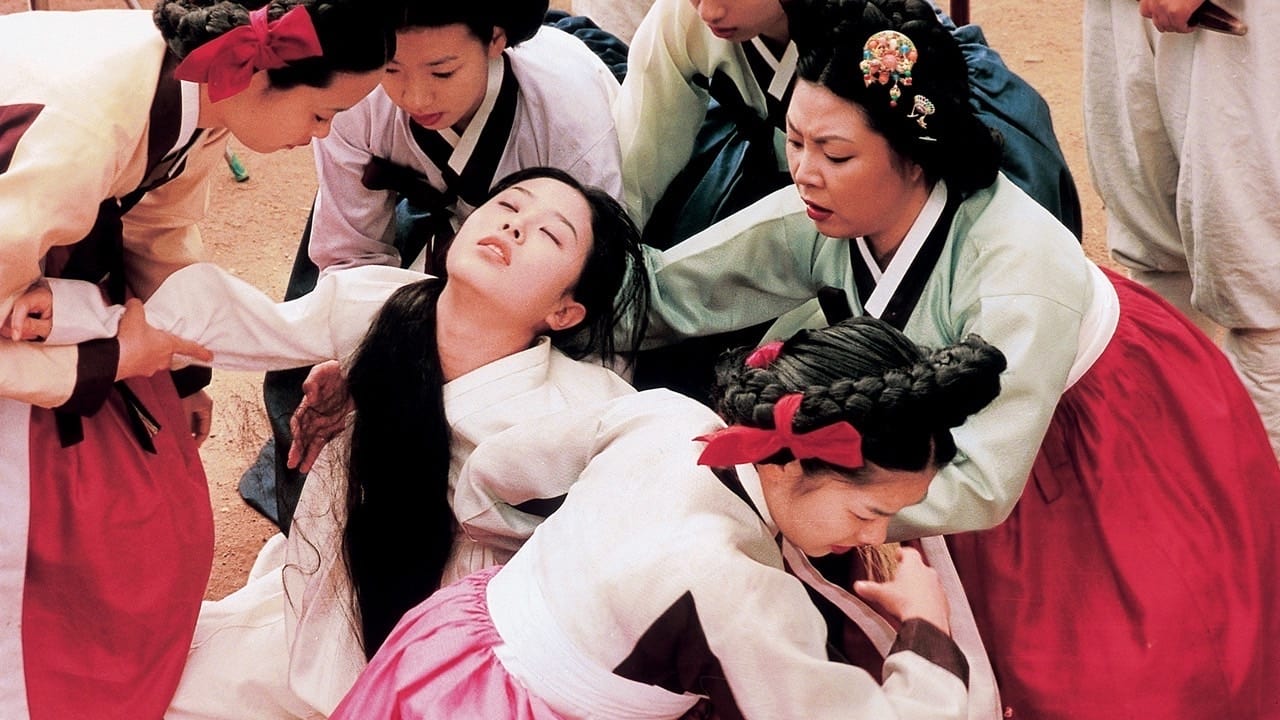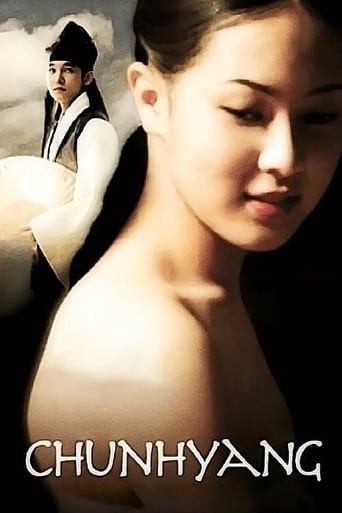

This is a Korean film telling the story of two lovers torn apart by class. The son of a governor and the daughter of a courtesan. It has the air of a fairytale and is a very good film.It may be difficult for some people to get into the film in the beginning if you are not familiar with pansori. Pansori is a centuries old Korean form of storytelling in which a storyteller sings the story while a drummer drums and makes short vocal sounds or words of encouragement. It is initially jarring for those of us who mostly watch American and European film, but stick with it. I first saw this in a film class and it was among two films that I wrote about for class and liked so much that I purchased on my own once the class ended.As the film begins the viewer is placed in the position of someone watching a pansori performance. From here the film transitions from the world of Chunhyang to the pansori audience. Part of the enjoyment of the film comes from watching the reactions of the pansori audience to the story. It is akin to being in a movie theater and sharing the same experiences with everyone else watching the film.Aside from the format, the story itself is enchanting, full of love, loyalty, and courage. The acting is very good and the actors are not bad looking themselves. The pansori performance is a song of the story so it has some poetic qualities that don't necessarily push the story forward, but are enjoyable if you are patient. All in all it is a look into Korean culture and storytelling that not many films from America, Europe, or the rest of the world do for their own cultures. Most films today just stick to the basic narrative design or are pretentious and abstract. This one creates a new experience for anyone who is willing to give it a chance.
... View MoreThere is nothing bland or pastel about Korea. It's traditional decorative colors, like the contrasts in its seasons, are vivid. In adapting social and political mores, as in the flavoring or food, Koreans tend to take things to extremes. South Korea, with its advertisements on pedestrian overpasses and across the bottom of the television screen, is in many ways more commercial and capitalistic than the archetype for such things, the United States, and its Christians are among the world's most fervent. North Korea, as we well know, has outdone Joseph Stalin and Mao Tse Tung with its rigid communist orthodoxy.Korea's national epic, the intensely romantic Chunhyang story, a tale better known in Korea than, say, Cinderella in the West, takes place in an old Korea that was almost a caricature of Confucianist China. The king was a complete autocrat and the social order was extremely hierarchical. Confucian norms, however, were supposed to ensure that the despotism was an enlightened and high-minded one. One could not be a part of the ruling bureaucracy without passing rigorous examinations that required knowledge of the Chinese classics and an ability to employ them in artistic expression along strictly prescribed lines. Education and refinement were supposed to translate themselves into wisdom and virtue in public administration.Although the lower orders may never have had it very good, for the most part the system worked. Strong, stable dynasties ruled for centuries in China and Korea, but no system created by man can guard against all human frailties. The temptation to abuse the power acquired through rising in the governmental organization was great, and Chunhyang, the "Cinderella" of this classic tale, runs afoul of one of the abusers. In the process, two Confucian requirements come into conflict with one another, loyalty of the wife to the husband and loyalty of the subject to the king or his duly vested agent.This is not a straightforward David and Bathsheba, story, however. There is just enough ambiguity in the husband-wife relationship to make it a close call for Chunhyang as to which loyalty should prevail. To her worldly courtesan mother it's not a close call at all. She counsels the easier route. But our heroine takes deeper counsel from within herself and follows the harder path that we know, as generations of Koreans have known, is in closer accord with universal moral law.To say more would be to give away the plot, but one wonders, with such a chastening tale as this as a part of their heritage, how any Korean officials could succumb to the temptation to abuse their authority and engage in corrupt practices. But East or West, the flesh is still weak, and the tale still needs retelling there as much as it needs telling here.Plays as we know them were unknown in Korea until the first decade of the twentieth century. The Chunhyang story was typically performed by a single p'ansori artist. P'ansori, which is quite foreign to the Western ear, is a sort of stylized chant in which the rasping tones of the performer help convey the setting and the emotion of the characters. The "singer" is accompanied by one other person who occasionally interjects exclamations and encouragement but mainly keeps time with a small barrel drum. P'ansori performers had to undergo even more rigorous training than opera singers in the West, though the purpose seemed to be to tear down the vocal cords rather than to build them up. A single P'ansori performance, lasting sometimes as long as eight hours, was a prodigious feat of stamina and memory. Thought to have grown out of the shaman performances of the southwest province of Cholla, p'ansori was acted out by both men and women. For most of the twentieth century the art form was kept alive mainly by kisaengs, or females of the roughly-translated "courtesan" class of which the Chunhyang character was a part.In the later twentieth century in Korea, while p'ansori was taken up by a broader spectrum of society interested in preserving Korea's traditions, the Chunhyang story was brought to the public in play, opera, and repeatedly in film form. In the early 60s, an Irish priest, a professor at the Jesuit Sogang University in Seoul, even wrote and directed a critically-acclaimed English-language Broadway-style musical version of the story.Director Kwon-taek Im for the first time combines p'ansori and drama in this latest film version. In so doing, he has produced an authentic work of art worthy of a Yi Dynasty scholar-official. Also, in the best Korean tradition, he has gone Hollywood one better at tugging at our heartstrings. The Korean audience on the screen applauds the p'ansori artist at the film's conclusion, and the audience of which I was a member, in a full opening-night movie theater, found itself joining them spontaneously. I think you will, too.Note: Don't be alarmed when the opening p'ansori monologue lacks English subtitles. They'll come soon enough. To provide them at that point would give away part of the plot. That's not a danger for the native Korean speakers, all of whom would know the plot by heart.
... View MoreThis is not just a movie, in the way that Americans, like myself, usually conceptualize contemporary film. Perhaps, it might be interesting, as a learning experience, to view "Chunghyang" with "Gladiator" to understand that these are two distinct art forms, devised by two distinct cultural traditions to tell important stories. I was thrilled to find this film so 'other', so un-American, so un-MTV. A Korean storytelling/operatic tradition is fused with beautiful filming. Dialogue, as the actors play out the story, is interlaced very comfortably with a storyteller's narrative in a sutra-chanting, poetic style, accompanied by one drummer. The storyteller's voice is a remarkable asset of the film. It has to be experienced to understand its power. I thought the film used very sophisticated editing to blend the highly operatic story line with the teller's narrative on stage and with a wonderful middle-Korean, as in middle-American, audience. This omniscient viewing perspective, affording views of several different levels of concurrent existence, was really wonderful. Then, I remembered in the middle of the film that I was reading subtitles without a trace of annoyance or distraction from the visuals. Very nicely done all around. I felt enriched, educated and entertained.
... View MoreThis movie is to be commended for the effortless interaction and interplay between the Pansori singing and the beautiful scenes of its 18th century location. The opening 3 minutes, without subtitles, are a wonderful way to pull English-speaking audiences into the unusual but compelling style of the Pansori singer. The movie itself uses colorful cinematography to tell its story. The story echoes many myths and legends from around the world and runs a bit long, but don't miss a chance to see this tribute to Korean folk traditions in a new setting. The actors are all quite good and the Pansori singer is outstanding.
... View More